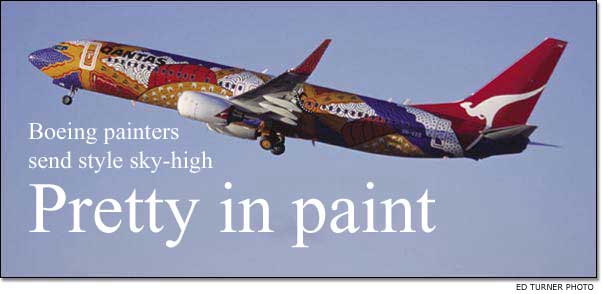|
||||||||
| Commercial Airplanes |
 BY DEBBY ARKELL
Just about every model of Boeing airplane currently in production has sported a unique livery in recent years. From U.S. carriers such as Southwest Airlines and American Airlines to international customers All Nippon Airways and Qantas, airlines sometimes opt for a distinctive, customized livery. Even the Boeing house livery has seen a few innovative touches lately. When customers call for custom liveries, Boeing Commercial Airplanes painters respond by painting jets with designers' finesse. Painting a commercial jet involves a process as detailed as the livery to be applied, though in general the steps have remained fairly constant over the years. "Commercial airplane skin panels arrive at Boeing covered with a temporary protective coating to protect the metal from damage or corrosion during the manufacturing and assembly processes," said Bill Dill, decorative paint manager in Commercial Airplanes' Everett, Wash., factory. "This is where the term 'green airplane' comes from; it references the green protective coating and implies that the product is unfinished, awaiting our handiwork." Paint shop employees first use a hand-sander on a completed airplane's previously primed surfaces, then tackle the green skins. They then mask off areas that need protecting, such as landing gear and engines, and apply detergent to the airplane to remove the coating. Next they wash the aircraft with a fire hose spraying water heated to 100 degrees Fahrenheit (38 C) to remove the green color. This leaves the natural, silver-colored aluminum skins. Once the jet is clean, painters sand or abrade the surface of the panels to ensure the primer coat adheres to the metal. They apply primer and then mask off areas of the jet and paint it in various stages, depending on the process for each customer's livery. They apply hand-detailing or decals last, prior to preparing the plane for delivery to the customer. The time needed to complete a paint job depends on the size of the airplane and the complexity of the livery. For example, while painting a typical livery on a 737 requires two to three days on a two-shift operation, the Qantas design required six days on a two-shift operation. Regardless of whether the work is a carrier's standard livery replicated precisely on every model in a fleet, or a livery based on a color drawing from a 12-year-old girl in Japan, the talented craftsmen and women in Boeing Commercial Airplanes paint shops finish Boeing airplanes with exacting care.
|
| Contact Us | Site Map| Site Terms | Privacy | Copyright | ||||||
| Copyright© Boeing. All rights reserved. |